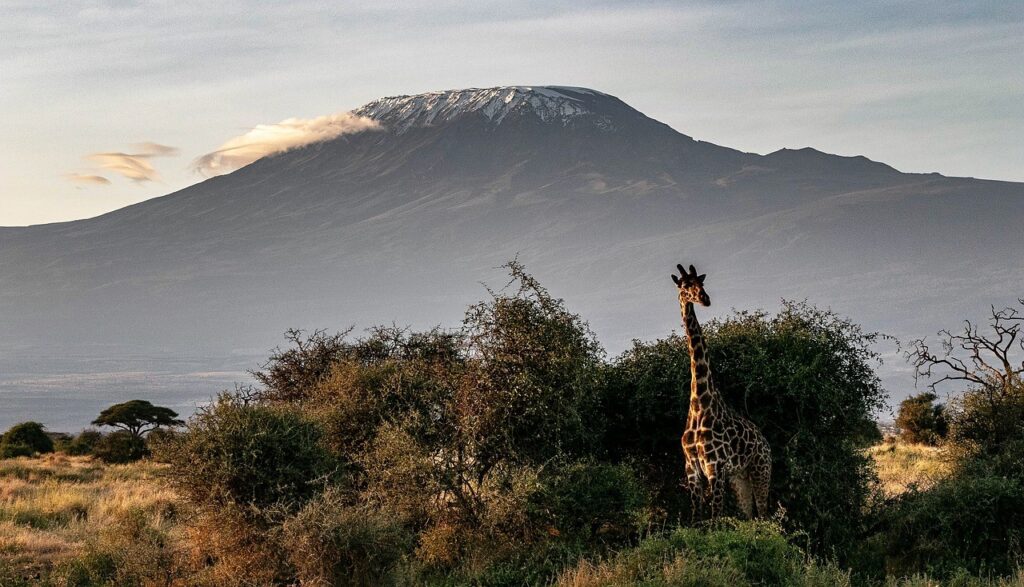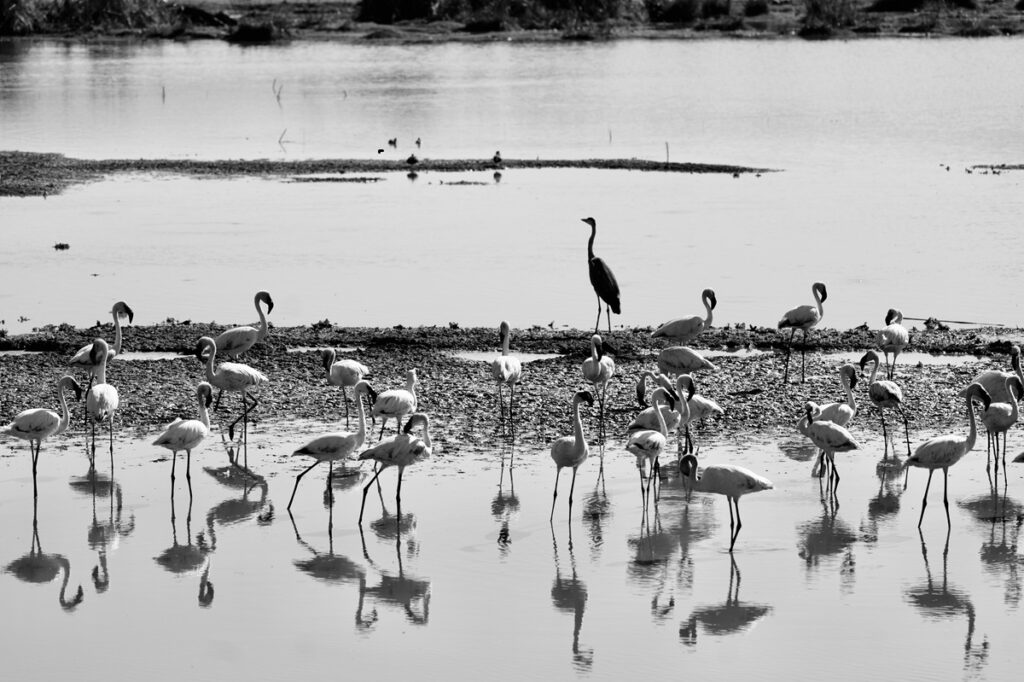Tanzania is home to the world-renowned Serengeti National Park, the location of the Great Wildebeest Migration. This annual natural phenomenon provides wildlife photographers with excellent opportunities to capture the scenes of over 1.5 million ungulates, zebras, and other herbivores crossing the plains. This is just the start of the incredible opportunities for photographic safaris in Tanzania!
The wildlife action doesn’t end there, though. Tanzania also plays host to the iconic Big Five (lion, elephant, buffalo, leopard, and rhino), as well as cheetahs, giraffes, and hippos. Tanzania’s Ngorongoro Crater is another bucket-list destination. This UNESCO World Heritage Site is a volcanic caldera teeming with wildlife and a prime spot for capturing stunning images against the backdrops of the crater walls.
There’s no shortage of professional guides in Tanzania. They’re well-versed in what makes a great photographic safari experience and will lead you to the best locations with their expert knowledge and guidance. For the wild at heart, Tanzania offers photographers off-the-beaten-path adventures like chimpanzee trekking in Mahale Mountains National Park or exploring the remote wilderness of Selous Game Reserve by boat.
If you’re looking for a fresh perspective, several safari operators in Tanzania offer hot air balloon safaris, the perfect way to capture dawn’s golden light spreading over the savannah below you. Of course, no Tanzania photographic safari is complete without a visit to one of the world’s most iconic tribes – the Maasai people. Photographers will have ample opportunity to document their vibrant culture, daily life, and ancient traditions while visiting the country.
Top 5 Destinations for a Photographic Safari in Tanzania
1. Mount Kilimanjaro
A majestic symbol of Africa, Mount Kilimanjaro is one of the top destinations for photographic safaris in Tanzania. Beyond capturing images of the snow-capped peaks towering above the African plains, photographic enthusiasts will have plenty to shoot on their trek to the summit-lush forests, alpine meadows, and unique fauna and flora. So there’s always something to point your camera at.
Capturing the sunrise or sunset from Kilimanjaro’s peak is guaranteed to deliver exceptional shots. And despite climate change, the mountain still boasts icefields and glaciers on its highest slopes. For those keen to hone their skills while visiting the mountain, some safari operators offer photographic workshops and guided expeditions to the summit. Looking for a slice of local culture? Kili is surrounded by diverse cultures, such as the Chagga people, who inhabit the foothills of the mountain. Visit them to capture their customs and traditions.

2. Ngorongoro Crater
With its steep crater walls enclosing a vast and fertile caldera, Ngorongoro Crater is a natural wonder and must-visit during a photographic safari in Tanzania. Wildlife and landscape photographers will have a wide range of settings to explore, from its open grasslands to dense forests and shimmering lakes. Expect epic views from the rim. The crater supports a dense wildlife population, including the Big Five. With over 500 bird species recorded, Ngorongoro is also a haven for avian photographers.
Ngorongoro Crater is easily accessible from major cities like Arusha and Moshi. Thanks to its proximity to popular safari destinations such as Tarangire National Park and the Serengeti, it’s a convenient stop for photographers exploring northern Tanzania. Professional guides in the area provide visiting photographers with expert knowledge and know exactly where to go to spot iconic game and other interesting photographic opportunities. While you’re in the area, visit the local Maasai people to capture their rich cultural heritage.

3. Mafia Beach
Situated on Mafia Island, Mafia Beach has picture-perfect beaches and warm, crystal-clear waters. Relatively undeveloped and off the beaten path, this stretch of coastline offers visiting photographers a slice of paradise complete with palm-fringed shores and epic sunrises and sunsets. Mafia Island is one of the best places in the world to encounter whale sharks. The rich surrounding marine biodiversity includes vibrant coral reefs, tropical fish, sea turtles, and dolphins – the perfect subjects to shoot while scuba diving or snorkelling.
The island is home to over 160 bird species, ideal for a photographic safari in Tanzania focused on sea eagles, herons, and flamingos. The island’s extensive mangrove forests can be explored by boat or kayak, offering a window into the world of these unique ecosystems. Known for its laid-back and peaceful atmosphere, Mafia Island’s locals include the indigenous Chole people and Swahili communities. Photographers can capture the activities of fishing villages, cultural ceremonies, and daily islander life.

4. Serengeti National Park
Home to the Great Wildebeest Migration, Serengeti National Park offers all the action of this annual phenomenon, including dramatic river crossings and nail-biting predator-prey interactions. While the migration is the major drawcard for a photographic safari in Tanzania, the park is worth visiting all year round for its diverse array of wildlife, including iconic species such as the Big Five, cheetahs, giraffes, and hyenas. Sweeping vistas, acacia-dotted plains, and rocky outcrops provide stunning backdrops, especially at sunrise and sunset.
With over 500 bird species recorded, the park is a paradise for avian photographers looking to capture anything from raptors to tiny, colourful songbirds. The park’s professional guides offer expert guidance, ensuring visiting photographers have the best opportunities to capture exceptional images. For photographers interested in local culture, head to a traditional Maasai village to capture ceremonies, dances, and ancient customs, or get above it all on a hot air balloon safari at dawn.

5. Lake Manyara National Park
Despite being one of Tanzania’s smaller parks, Lake Manyara National Park is home to a wide variety of wildlife, including elephants, buffalo, giraffes, zebras, wildebeest, numerous bird species, and unusual tree-climbing lions. A UNESCO World Heritage Site, the park’s lush groundwater forests and acacia woodlands to grassy plains and Lake Manyara itself, provide apple opportunities for incredible Tanzania photographic safaris.
These habitats support a rich avian biodiversity, with over 400 species recorded. The park is also situated in the heart of Maasai country, giving photographers the opportunity to document traditional village life and vibrant local customs and culture. Game drives led by professional guides help photographers locate wildlife and other interesting photographic opportunities and, with fewer crowds than other parks, the atmosphere is more intimate.

Tanzania photographic safaris offer travellers a plethora of stunning landscapes and incredible wildlife encounters to capture. Planning a photographic safari doesn’t need to be complicated. Speak to a safari expert at Discover Africa today to start planning your tailor-made photographic safari.
Author: Adelle Bell
Published:
Last Update:
Part of the East Africa Safari & Great Migration Safaris Collections